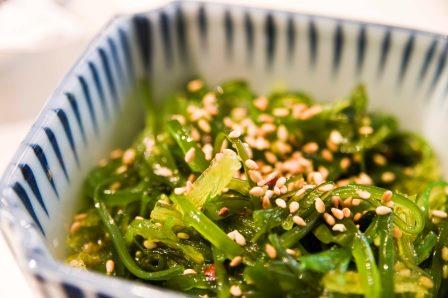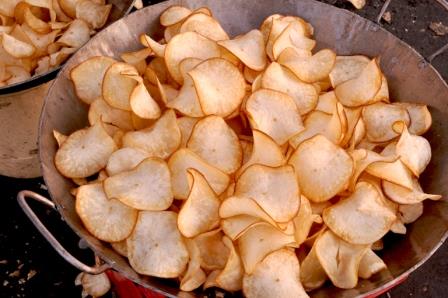February 29, 2016
By Anna Varriano
 [printfriendly]
[printfriendly]
March is National Nutrition month, so I thought it would be interesting to share what the Canadian Health Food Association has identified as the top five natural health trends for 2016, and of course, to add my two cents worth.
1 – Sea Greens
 Sea greens (aka sea vegetables) include things like kelp, dulse, nori, wakame, sea asparagus, and a variety of algae. Sea greens are rich in numerous vitamins and minerals – including a wide variety of trace minerals that many of us don’t get enough of through other foods. Sea greens are famous for being an excellent source if iodine – a mineral that is critical to thyroid health, in particular the production of thyroid hormones, which many people have issues with. Thyroid hormones help to regulate our metabolism (which is associated with energy levels and weight management), as well as blood calcium levels (which affect our bone health and hundreds of other processes in the body).
Sea greens (aka sea vegetables) include things like kelp, dulse, nori, wakame, sea asparagus, and a variety of algae. Sea greens are rich in numerous vitamins and minerals – including a wide variety of trace minerals that many of us don’t get enough of through other foods. Sea greens are famous for being an excellent source if iodine – a mineral that is critical to thyroid health, in particular the production of thyroid hormones, which many people have issues with. Thyroid hormones help to regulate our metabolism (which is associated with energy levels and weight management), as well as blood calcium levels (which affect our bone health and hundreds of other processes in the body).
Try dulse and kelp flakes as a substitite to table salt. Seaweed salads are also now available at many restaurants and grocery stores. There are also a number of dried and roasted seaweed snacks on the market; however, many of them use unhealthy oils, including corn and soy oil. Make sure you read the ingredients on all sea green products! It doesn’t take much to turn a healthy food into a junk food!
2 – Vitamins C and D
I’ve been promoting the benefits of vitamin D for years, so I won’t spend any time discussing them in this post. A search of vitamin D on my website will give you plenty of reading to do on the topic.
As for vitamin C, most people associate it with boosting the immune system to prevent colds and flus, which is definitely one of the benefits that it offers. What many people don’t know is that the body needs sufficient levels of vitamin C to support the production of collagen.
body needs sufficient levels of vitamin C to support the production of collagen.
Collagen is the most abundant protein in the body and basically acts as a strong yet flexible ‘glue’ to hold us together. It is an important part of our bones, muscles, tendons, and skin. Good food sources of vitamin C include red, yellow, and orange bell peppers, papaya, broccoli, Brussels sprouts, berries, citrus fruit, and kiwi. A great food source of collagen is stock or broth made from bones with some meat and lots of connective tissue surrounding them (e.g. joints, shanks, chicken feet, etc). Instead of putting vitamin C and collagen-containing beauty products on your skin, nourish your skin from the inside out by eating vitamin C and collagen rich foods!
3 – Sweet and Savoury Treats with a Health Kick
 The savoury treats in this category include snacks like chips made from foods such as beans, lentils, beets and other root veggies. My issue with these snacks is that many of them are no better than more common junk foods once you’ve baked or fried them at high temperatures with inflammation-promoting omega-6 oils such as safflower, sunflower, corn, or soy. Be aware that eating a bag of beet chips is not going to give you the same nutritional benefits of eating a raw or steamed beet! In my opinion, many of these snacks are more-or-less junk foods marketed as health foods.
The savoury treats in this category include snacks like chips made from foods such as beans, lentils, beets and other root veggies. My issue with these snacks is that many of them are no better than more common junk foods once you’ve baked or fried them at high temperatures with inflammation-promoting omega-6 oils such as safflower, sunflower, corn, or soy. Be aware that eating a bag of beet chips is not going to give you the same nutritional benefits of eating a raw or steamed beet! In my opinion, many of these snacks are more-or-less junk foods marketed as health foods.
Chocolate tops the list for the sweet treats. I’ve shared information on chocolate in previous blog posts. The greatest benefits are derived from the anti-oxidants contained in raw, unprocessed cacao nibs . One of the greatest benefits associated to these anti-oxidants is cardiovascular health, including improved blood flow and a decrease in blood pressure. The important thing to remember here is that not all chocolate is created equal!
4 – Hemp
Hemp has received so much hype over the years … hemp oil, hemp seeds, hemp protein powder – it seems more and more health food items are using it as an ingredient, and yet, I am still hesitant about it and don’t buy it myself. My understanding is that while many sources claim it is a good source of protein and essential fatty acids (EFAs), hemp’s EFAs are mostly in the form of omega-6 and not in the form of omega-3. Unfortunately, most people get way too many omega-6s in their diet and not nearly enough omega-3s, and this sets the stage for inflammation, which is at the root of most diseases. I feel that most people really need to significantly boost their omega-3 EFAs, so for the time being, I’m sticking with chia seeds and flax seeds – and I’ll get my protein from one of the most bioavailable sources – eggs.
hesitant about it and don’t buy it myself. My understanding is that while many sources claim it is a good source of protein and essential fatty acids (EFAs), hemp’s EFAs are mostly in the form of omega-6 and not in the form of omega-3. Unfortunately, most people get way too many omega-6s in their diet and not nearly enough omega-3s, and this sets the stage for inflammation, which is at the root of most diseases. I feel that most people really need to significantly boost their omega-3 EFAs, so for the time being, I’m sticking with chia seeds and flax seeds – and I’ll get my protein from one of the most bioavailable sources – eggs.
5 – Fibre
 Getting enough fibre isn’t a new nutrition concept, so I’m not sure why it was identified as a ‘new’ trend for 2016. The health benefits of fibre are associated to the fact that it promotes regular bowel movements. Stool (aka poop) is the body’s major vehicle for getting rid of stuff the body doesn’t want, including toxins and excess cholesterol and hormones. A diet lacking in fibre will lead to constipation, and if poop starts sitting around in your colon, you’ll start reabsorbing the substances your body was trying to get rid of. Natural health practitioners refer to this as ‘auto-intoxication’.
Getting enough fibre isn’t a new nutrition concept, so I’m not sure why it was identified as a ‘new’ trend for 2016. The health benefits of fibre are associated to the fact that it promotes regular bowel movements. Stool (aka poop) is the body’s major vehicle for getting rid of stuff the body doesn’t want, including toxins and excess cholesterol and hormones. A diet lacking in fibre will lead to constipation, and if poop starts sitting around in your colon, you’ll start reabsorbing the substances your body was trying to get rid of. Natural health practitioners refer to this as ‘auto-intoxication’.
The recommended daily fibre intake is 25-35 grams; however, most people don’t even get a third of that, which is unfortunate when you think of some of the health benefits associated with dietary fibre, including: blood sugar control, cardiovascular health, and weight management. While fibre is important for digestive health, individuals with certain gut imbalances may not be able to tolerate many forms of fibre.
So many foods are good sources of fibre, with some notable ones being chia seeds, cruciferous vegetables (e.g. broccoli, Brussels sprouts), squash, sweet potatoes, root vegetables, beans, lentils, apples, and oats (avoid the little flavoured packets of oatmeal loaded with sugar and go for steel cut oats instead).
So there you have it. Which of the above trends for 2016 will you embrace?
References:
https://www.chfa.ca/en/natural-health-trends-2016.html
[printfriendly]Join my email list and start living healthier!
- Tips & advice on healthier living
- Special promotions & offers
- Sent a few times a month to your inbox

Subscribe today and you'll receive a free e-guide that outlines the four key supplements you need for lifelong health!